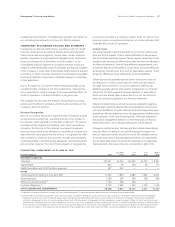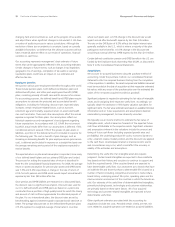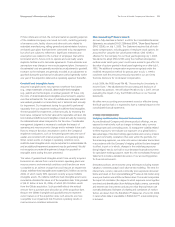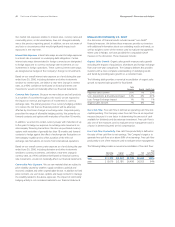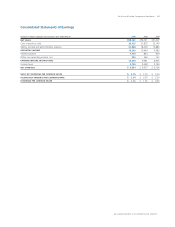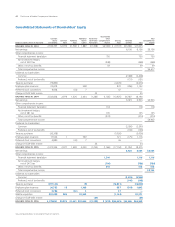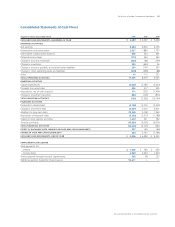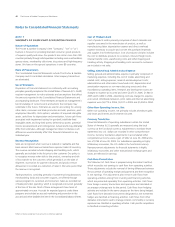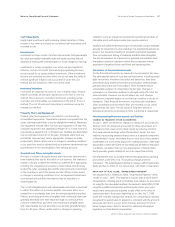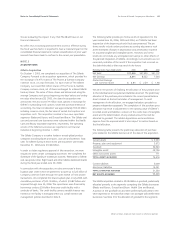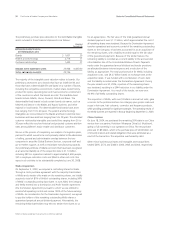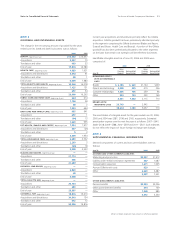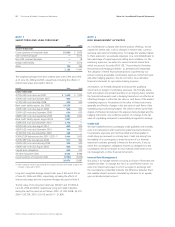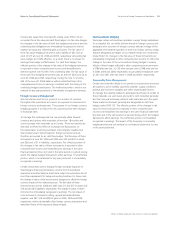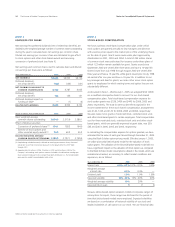Proctor and Gamble 2006 Annual Report Download - page 48
Download and view the complete annual report
Please find page 48 of the 2006 Proctor and Gamble annual report below. You can navigate through the pages in the report by either clicking on the pages listed below, or by using the keyword search tool below to find specific information within the annual report.Millions of dollars except per share amounts or otherwise specified.
The Procter &Gamble Company and Subsidiaries
46
Notes to Consolidated Financial Statements
NOTE 1
SUMMARY OF SIGNIFICANT ACCOUNTING POLICIES
Nature of Operations
The Procter &Gamble Company’s (the “Company,” “we” or “us”)
business is focused on providing branded consumer goods products
of superior quality and value. Our products are sold in more than 180
countries primarily through retail operations including mass merchandisers,
grocery stores, membership club stores, drug stores and high-frequency
stores. We have on-the-ground operations in over 80 countries.
Basis of Presentation
The Consolidated Financial Statements include The Procter &Gamble
Company and its controlled subsidiaries. Intercompany transactions
are eliminated.
Use of Estimates
Preparation of financial statements in conformity with accounting
principles generally accepted in the United States of America (U.S. GAAP)
requires management to make estimates and assumptions that affect
the amounts reported in the Consolidated Financial Statements and
accompanying disclosures. These estimates are based on management‘s
best knowledge of current events and actions the Company may
undertake in the future. Estimates are used in accounting for, among
other items, consumer and trade promotion accruals, pensions, post-
employment benefits, stock options, valuation of acquired intangible
assets, useful lives for depreciation and amortization, future cash flows
associated with impairment testing for goodwill, indefinite-lived
intangible assets and long-lived assets, deferred tax assets, potential
income tax assessments and contingencies. Actual results may ultimately
differ from estimates, although management does not believe such
differences would materially affect the financial statements in any
individual year.
Revenue Recognition
Sales are recognized when revenue is realized or realizable and has
been earned. Most revenue transactions represent sales of inventory.
The revenue recorded includes shipping and handling costs, which
generally are included in the list price to the customer. Our policy is
to recognize revenue when title to the product, ownership and risk
of loss transfer to the customer, which generally is on the date of
shipment. A provision for payment discounts and product return
allowances is recorded as a reduction of sales in the same period that
the revenue is recognized.
Trade promotions, consisting primarily of customer pricing allowances,
merchandising funds and consumer coupons, are offered through
various programs to customers and consumers. Sales are recorded net
of trade promotion spending, which is recognized as incurred, generally
at the time of the sale. Most of these arrangements have terms of
approximately one year. Accruals for expected payouts under these
programs are included as accrued marketing and promotion in the
accrued and other liabilities line item in the Consolidated Balance Sheets.
Cost of Products Sold
Cost of products sold is primarily comprised of direct materials and
supplies consumed in the manufacture of product, as well as
manufacturing labor, depreciation expense and direct overhead
expense necessary to acquire and convert the purchased materials
and supplies into finished product. Cost of products sold also includes
the cost to distribute products to customers, inbound freight costs,
internal transfer costs, warehousing costs and other shipping and
handling activity. Shipping and handling costs invoiced to customers
are included in net sales.
Selling, General and Administrative Expense
Selling, general and administrative expense is primarily comprised of
marketing expenses, including the cost of media, advertising and
related costs; selling expenses; research and development costs;
administrative and other indirect overhead costs; depreciation and
amortization expense on non-manufacturing assets and other
miscellaneous operating items. Research and development costs are
charged to expense as incurred and were $2,075 in 2006, $1,940 in
2005 and $1,802 in 2004. Advertising costs are charged to expense
as incurred. Worldwide television, print, radio and Internet advertising
expenses were $6,773 in 2006, $5,917 in 2005 and $5,504 in 2004.
Other Non-Operating Income, Net
Other non-operating income, net primarily includes divestiture gains
and losses and interest and investment income.
Currency Translation
Financial statements of operating subsidiaries outside the United
States of America (U.S.) generally are measured using the local
currency as the functional currency. Adjustments to translate those
statements into U.S. dollars are recorded in other comprehensive
income. Currency translation adjustments in accumulated other
comprehensive income were a gain of $522 at June 30, 2006 and a
loss of $794 at June 30, 2005. For subsidiaries operating in highly
inflationary economies, the U.S. dollar is the functional currency.
Remeasurement adjustments for financial statements in highly
inflationary economies and other transactional exchange gains and
losses are reflected in earnings.
Cash Flow Presentation
The Statement of Cash Flows is prepared using the indirect method,
which reconciles net earnings to cash flow from operating activities.
These adjustments include the removal of timing differences between
the occurrence of operating receipts and payments and their recognition
in net earnings. The adjustments also remove cash flows from
operating activities arising from investing and financing activities,
which are presented separately from operating activities. Cash flows
from foreign currency transactions and operations are translated at
an average exchange rate for the period. Cash flows from hedging
activities are included in the same category as the items being hedged.
Cash flows from derivative instruments designated as net investment
hedges are classified as financing activities. Cash flows from other
derivative instruments used to manage interest, commodity or currency
exposures are classified as operating activities. Cash paid for acquisitions
is classified as investing activities.



